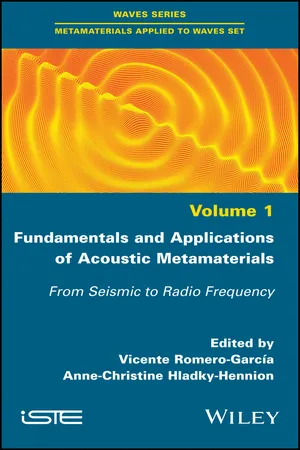1.1. Introduction
Acoustic metamaterials are man-made composite structures whose acoustic properties are new in comparison with that of the components used in their construction. Recent review articles have reported the many fascinating devices based on their extraordinary properties [CUM 16, MA 16, HAB 16]. Among them, acoustic cloaking and negative refraction are phenomena that are currently used to develop devices like noise shelters, acoustic imaging with subwavelength resolution, focusing devices and many others. On the one hand, acoustic cloaking is obtained thanks to the possibility of engineering artificial structures behaving like acoustic materials with an effective anisotropic dynamical mass density [CUM 07, TOR 08]. Later, it was demonstrated that cloaking is also possible with structures with an effective anisotropic bulk modulus, having simultaneously an effective isotropic dynamical mass. On the other hand, negative refraction arises because of the possibility of engineering structures whose effective acoustic parameters (i.e. mass density and bulk modulus) are both negative. Metamaterials with double-negative parameters can be obtained by tailoring structures that have both monopole and dipole resonances [LI 04]. In addition, negative refraction has been also demonstrated using space-coiling acoustic metamaterials [KOC 49, LIA 12, XIE 13] and hyperbolic materials [GAR 14].
The effect of losses in acoustic metamaterials has been scarcely tackled though dissipation seems to play a fundamental role in explaining the degradation of the predicted performance in many manufactured structures. As a typical example, let us mention the case of three-dimensional labyrinthine acoustic metamaterials characterized by Frenzel et al. [FRE 13], who found a significant amount of losses that led them to propose these structures for subwavelength broadband all-angle acoustic absorbers. A recent study by Molerón et al. [MOL 16] demonstrated that the actual response of these structures with subwavelength slits in air strongly depends on the viscothermal losses. Previously, it was shown that slow sound propagation observed in waveguides with side resonators was produced by viscothermal dissipation [THE 14]. For the case of metamaterials based on local resonances, the authors claimed the expected double-negative behavior in two specifically designed structures was unobservable, due to the strong influence of viscothermal effects [FOK 11, GRA 13].
This chapter is devoted to study the contribution of viscothermal effects in some specific acoustic metamaterials. Particularly, in those whose negative effective parameters are a consequence of embedded resonances in the building units. First, we briefly report the different approaches developed in order to study viscothermal losses in environments where their expected contribution is relevant. The finite element method (FEM) and the boundary element method (BEM) can be used when explaining the properties of artificial structures with corrugated surfaces where viscothermal losses are relevant, like the ones analyzed here. We have selected the BEM as the more adequate to study the metamaterial samples based on local resonances and therefore we explain this method with some detail in section 1.2.1. Then, in section 1.3, the BEM is applied to comprehensively study the case of a single-negative metamaterial. This quasi-two-dimensional metamaterial structure is made of a two-dimensional (2D) waveguide with a square distribution of drilled holes [GRA 12] and effectively behaves as a material with negative bulk modulus as the one introduced by Fang et al. [FAN 06]. It will be shown that the viscothermal losses, although relevant, do not destroy the observation of the negative modulus theoretically predicted. However, this is not the conclusion obtained for the case studied in section 1.4, where the quasi-2D metamaterial has cylindrical inclusions with a periodically corrugated surface and was designed to show double-negative behavior. For this double-negative metamaterial, the viscothermal losses play a paramount importance and its contribution completely destroys the expected behavior, giving support to the experimental data [CUT 17b]. Anyway, we have to stress that the effect of viscothermal losses has been studied for two specific cases and cannot be directly extrapolated to all cases. However, the...
